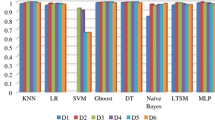Abstract
The wireless sensor networks (WSNs) have imminent constrains that makes security a crucial issue. Weak defense capability makes WSN a soft target against worm attacks. A single compromised node can spread the worm via communication in the entire network. In this paper, we propose a mathematical model that studies the epidemic behavior of such digital worms. Furthermore, we study the effect of these worms with various communication radius and node distributed density. We investigate the proposed model using the stability theory of differential equations. Basic reproduction number is found that helps us to find the threshold values for communication radius and node density distribution. The proposed model is checked and validated through extensive simulation results. Finally, we compare our scheme with the existing schemes. Comparison analysis shows that the proposed model is efficient as it has the low rate of the infectious node for different communication radius.











Similar content being viewed by others
References
Hui, J. W., & Culler, D. (2004). The dynamic behavior of a data dissemination protocol for network programming at scale. In Proceedings of the 2nd international conference on embedded networked sensor systems (pp. 8194). ACM.
Boyd, S., Ghosh, A., Prabhakar, B., & Shah, D. (2005). Gossip algorithms: Design, analysis and applications. In Proceedings IEEE 24th annual joint conference of the IEEE computer and communications societies (Vol. 3, pp. 16531664). IEEE.
Kermack, W. O., & McKendrick, A. G. (1927). A contribution to the mathematical theory of epidemics. In Proceedings of the royal society of London A: mathematical, physical and engineering sciences (Vol. 115, pp. 700721). The Royal Society.
Heesterbeek, J. A. P., & Dietz, K. (1996). The concept of \(R_0\) in epidemic theory. Statistica Neerlandica, 50(1), 89110.
Anderson, R., & May, R. (1991). Infectious diseases of humans: Dynamics and control (p. 757). Oxford: Oxford university press.
Staniford, S., Paxson, V., & Weaver, N., et al. (2002). How to own the internet in your spare time. In USENIX security symposium (pp. 149167).
Van den Driessche, P., & Watmough, J. (2002). Reproduction numbers and sub-threshold endemic equilibria for compartmental models of disease transmission. Mathematical Biosciences, 180(1), 2948.
Khelil, A., Becker, C., Tian, J., & Rothermel, K. (2002). Directed-graph epidemiological models of computer viruses. In Proceedings of the 5th ACM international workshop on modeling analysis and simulation of wireless and mobile systems (pp. 5460).
Khayam, S. A., & Radha, H. (2005). A topologically-aware worm propagation model for wireless sensor networks. In 25th IEEE international conference on distributed computing systems workshops (pp. 210216). IEEE.
Akdere, M., Bilgin, C. C., Gerdaneri, O., Korpeoglu, I., Ulusoy, O., & Cetintemel, U. (2006). A comparison of epidemic algorithms in wireless sensor networks. Computer Communications, 29(13), 24502457.
Zheng, H., Li, D., & Gao, Z. (2006). An epidemic model of mobile phone virus. In 2006 first international symposium on pervasive computing and applications (pp. 15). IEEE.
De, P., Liu, Y., & Das, S. K. (2006). Modeling node compromise spread in wireless sensor networks using epidemic theory. In Proceedings of the 2006 international symposium on world of wireless, mobile and multimedia networks (pp. 237243). IEEE Computer Society.
Tang, S., & Mark, B. L. (2009). Analysis of virus spread in wireless sensor networks: An epidemic model. In 7th international workshop on design of reliable communication networks, 2009. DRCN 2009 (pp. 8691). IEEE.
Tang, S. (2011). A modified SI epidemic model for combating virus spread in wireless sensor networks. International Journal of Wireless Information Networks, 18(4), 319326.
Wang, X., & Li, Y. (2009). An improved SIR model for analyzing the dynamics of worm propagation in wireless sensor networks. Chinese Journal of Electronics, 18(1), 812.
Mishra, B. K., & Keshri, N. (2013). Mathematical model on the transmission of worms in wireless sensor network. Applied Mathematical Modelling, 37(6), 41034111.
Feng, L., Song, L., Zhao, Q., & Wang, H. (2015). Modeling and stability analysis of worm propagation in wireless sensor network. Mathematical Problems in Engineering. doi:10.1155/2015/129598.
Zhu, L., Zhao, H., & Wang, X. (2015). Bifurcation analysis of a delay reactiondiffusion malware propagation model with feedback control. Communications in Nonlinear Science and Numerical Simulation, 22(1), 747768.
Acknowledgements
Authors are very thankful to D.P. Singh for various fruitful discussions which helped us to improve our work.
Author information
Authors and Affiliations
Corresponding author
Rights and permissions
About this article
Cite this article
Singh, A., Awasthi, A.K., Singh, K. et al. Modeling and Analysis of Worm Propagation in Wireless Sensor Networks. Wireless Pers Commun 98, 2535–2551 (2018). https://doi.org/10.1007/s11277-017-4988-3
Published:
Issue Date:
DOI: https://doi.org/10.1007/s11277-017-4988-3




